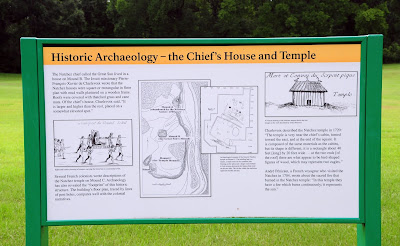Stories of the South - Grand Village of the Natchez Indians
I’ve been going to Natchez for almost 10 years now as my husband’s family is from there. Every time I go I try and see something new which is pretty easy in a town as steeped in history as Natchez. One place I’ve wanted to see for several years is the Grand Village of the Natchez Indians. It’s located right off highway 61 in the city limits at the end of a dead end street in a very ordinary looking residential neighborhood. But at the end of the street this sign and historical marker are here to greet you.
The Grand Village of the Natchez was the main religious and political capital for the Natchez between the late 17th and the early 18th century. The Grand Village is a 128 acre site on the banks of St. Catherine’s Creek that contains three prehistoric Native American Mounds, a reconstruction of a Natchez Indian home, nature trail, and museum. It’s open 7 days a week and is free to enter! A link to their website is HERE which gives directions and hours. I grew up being fascinated by the Indian mounds in North Mississippi at Bynum and Owl Creek built by the Chickasaw and the Naniya Mounds in Southern Noxubee County built by the Choctaw. Honestly though I didn’t realize that the Natchez mounds were even there much less that there was a tribe called the Natchez. I had never even heard of them. There is not a lot online so I’m definitely mad at myself now for not purchasing a book in the gift shop, but I’ll share what I was able to find.
The Natchez were some of the last Indian tribes to live in what we now call Southwest Mississippi. Natchez culture began somewhere around 700 A.D. and lasted until the 1730’s when altercations with the French caused them to give up their ancestral home. Before European settlement they were successful farmers growing corn, beans, and squash while also hunting, fishing, and gathering wild plants. The Grand Village was their second ceremonial mound complex with the first being the Emerald Mound located to the north about 14 miles away. The Emerald Mound can also be visited and is located off the Natchez Trace Parkway - something else to add to my list of stuff I want to do in Natchez. They moved to the new location on St. Catherine’s Creek somewhere before contact with the Spanish in the 1600’s. The first European contact is thought to be with the expedition led by Hernando DeSoto in 1542-1543. The population reduced drastically after this contact due to the diseases carried by the Spanish such as smallpox, measles, and bubonic plague. So when the first documented contact occurred in 1682 when Rene-Robert Cavelier and Sieur de La Salle’s expedition came down the Mississippi River they were a very different people than DeSoto had met. Following La Salle’s meeting with the Natchez they were frequently visited by other French and English explorers, priests, and military personnel. Eventually the French established Fort Rosalie and Natchez in 1716 and it quickly became the center of the new colony. Over the next 13 years the colony of Natchez grew as did the tensions between the French, the English, and the native Natchez Indians.
Things finally boiled over due to French confiscation of Natchez Indian land after the death of their leader the Great Sun in 1728. In 1729 the Natchez rebelled and attacked Fort Rosalie killing most of the soldiers stationed there. The French attacked the Natchez in 1730 aided by their Choctaw Indian allies. The French and Choctaw used the Grand Village as their staging point to lay siege to the Natchez. The Great Mound, former home to the Great Sun, was used as storage for artillery. This confrontation with the French was the beginning of the end for the Natchez nation. While the Natchez never formally surrendered they did choose to leave their lands and join the tribes of the Chickasaw, Creeks, and Cherokees as refugees. Those that did not leave, around 300 or so, were captured by the French and sold into slavery in the West Indies where there were several French colonies. Today Natchez Indians have descendants living in the southern Appalachian mountain areas and in Oklahoma.
With a little history behind us let’s explore the mounds themselves. Mounds have been built since prehistoric times in many parts of North and South America. The mounds at the Grand Village stand about 8 feet high and rise in several stages as structures on top were torn down and rebuilt according to religious and political ceremony. Construction is estimated to have begun in the 13th century. Only a few high ranking tribal leaders lived at the mounds full time. The majority of the tribe lived scattered on individual family farms in the surrounding area. There are a few 18th century first hand accounts of the ceremonies that were conducted there and give descriptions of the traditions that were nearly extinct by the time Europeans arrived. The Chief of the Natchez, I mentioned earlier, was called the Great Sun and did live at the Grand Village full time. His home stood on the center mound which has been excavated and built back to the original size and shape. The second mound is the Temple Mound located on the southern part of the property. Within the temple a fire was kept burning day and night. Foundation remains of the Great Sun’s home and the temple were found in 1962.
A mound located at the north end of the site is called the abandoned mound and was no longer in use when the Europeans arrived. This mound has been investigated but has remained largely undisturbed and will remain this way keeping it as a time capsule for that era. The Grand Village of the Natchez Indians is a National Historic Landmark administered by the Mississippi Department of Archives and History with the museum accredited by the American Association of Museums. They have a pretty good informational movie for you to watch, examples of Natchez pottery and tools, and a small selection of books. I’m still mad at myself I didn’t get one!
I went in July while we were at the Mississippi Ducks Unlimited State Convention and while I really enjoyed my visit I absolutely melted! Natchez in July is sweltering to say the least. I really wanted to walk and explore the nature trail area and see St. Catherine’s Creek but after walking and looking at the mounds I had sweated completely through my clothes. Maybe next time. The site is also host to the annual Natchez Powwow featuring dancing, foods, crafts, and more. Descendants of the Natchez from all over the country attend the weekend event each spring. Definitely something to look at in the future.
I hope you enjoyed this! I love Native American history and have since I was a little girl. If you did like this, please let me know as I have a site in Noxubee County I am going to write about sometime soon. Thanks so much as always for reading! I know this one was a long one!

















Wonder if there is any history of how the city came to aquire and maintain this. I grew up just across St Catherine Creek from the village and my brother and I uncoverd a burial site on the other side of the creek. We had some indian pots and stuff. My older bother somehow knew the smithsonian was coming through town. they came out and investigated our location, Finding scull fragments and other pottery. This was well before there was an indian village. We actually used to ride bikes across the mounds not knowing what they were. This would have been late 60s maybe early 70s
ReplyDeleteHow cool! I think you've asked the one question I didn't think to look up. How embarrasing! I bet I missed it at the museum that day. I had just a short time to look around and it was SOOOO HOOOOTTT that day I thought I would just sweat away into a puddle. Natchez in July is no joke. I did look and find that the site is maintained by the Mississippi Department of Archives and History, but a quick look did not show how they acquired the site.
DeleteThis did inspire me to research a bit more. it was a group from harvard. they were in this area for about 10 years. there is a detailed publicariin but north site was only a small part
Delete